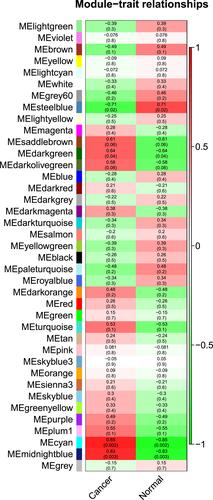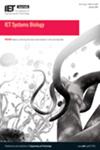长链非编码rna及其作为乳腺癌潜在生物标志物的靶点
IF 1.9
4区 生物学
Q4 CELL BIOLOGY
引用次数: 1
摘要
乳腺癌是全球死亡率很高的致命癌症之一。通过改进疾病特异性生物标志物的分析和鉴定,可以控制其高患病率。最近,长链非编码rna (lncRNAs)被报道为致癌的关键贡献者,并通过转录后调控机制调节多种细胞通路。本研究的具体目的是通过对lncrna和mrna的公开表达谱进行综合分析,确定乳腺癌中异常表达的遗传成分的新相互作用。通过比较样本与对照组的乳腺癌表达谱,确定了差异表达模式。通过WGCNA分析发现了显著的共表达网络。WGCNA是一种系统生物学方法,用于阐明基因在微阵列样本之间的相关模式。它还用于识别高度相关的模块。本研究结果显示,lncRNAs及其顺式和反式调控mRNA靶点存在显著差异表达和共表达,包括靶向TAF5L的RP11-108F13.2、靶向CYP4F3、CYP4F8的RPL23AP2和靶向LRP5L、AL022324.3、Z99916.3的AL022324.2。此外,通路分析揭示了鉴定的mrna和lncrna参与主要的细胞信号通路,并通过队列数据验证了靶mrna的表达。因此,鉴定的lncrna及其靶mrna代表了新的生物标志物,可以作为乳腺癌的潜在治疗药物,它们的作用也可以通过湿实验室进一步验证,以在未来将其作为潜在的治疗靶点。本文章由计算机程序翻译,如有差异,请以英文原文为准。

Long non-coding RNAs and their targets as potential biomarkers in breast cancer
Abstract Breast cancer is among the lethal types of cancer with a high mortality rate, globally. Its high prevalence can be controlled through improved analysis and identification of disease‐specific biomarkers. Recently, long non‐coding RNAs (lncRNAs) have been reported as key contributors of carcinogenesis and regulate various cellular pathways through post‐transcriptional regulatory mechanisms. The specific aim of this study was to identify the novel interactions of aberrantly expressed genetic components in breast cancer by applying integrative analysis of publicly available expression profiles of both lncRNAs and mRNAs. Differential expression patterns were identified by comparing the breast cancer expression profiles of samples with controls. Significant co‐expression networks were identified through WGCNA analysis. WGCNA is a systems biology approach used to elucidate the pattern of correlation between genes across microarray samples. It is also used to identify the highly correlated modules. The results obtained from this study revealed significantly differentially expressed and co‐expressed lncRNAs and their cis‐ and trans‐regulating mRNA targets which include RP11‐108F13.2 targeting TAF5L, RPL23AP2 targeting CYP4F3, CYP4F8 and AL022324.2 targeting LRP5L, AL022324.3, and Z99916.3, respectively. Moreover, pathway analysis revealed the involvement of identified mRNAs and lncRNAs in major cell signalling pathways, and target mRNAs expression is also validated through cohort data. Thus, the identified lncRNAs and their target mRNAs represent novel biomarkers that could serve as potential therapeutics for breast cancer and their roles could also be further validated through wet labs to employ them as potential therapeutic targets in future.
求助全文
通过发布文献求助,成功后即可免费获取论文全文。
去求助
来源期刊

IET Systems Biology
生物-数学与计算生物学
CiteScore
4.20
自引率
4.30%
发文量
17
审稿时长
>12 weeks
期刊介绍:
IET Systems Biology covers intra- and inter-cellular dynamics, using systems- and signal-oriented approaches. Papers that analyse genomic data in order to identify variables and basic relationships between them are considered if the results provide a basis for mathematical modelling and simulation of cellular dynamics. Manuscripts on molecular and cell biological studies are encouraged if the aim is a systems approach to dynamic interactions within and between cells.
The scope includes the following topics:
Genomics, transcriptomics, proteomics, metabolomics, cells, tissue and the physiome; molecular and cellular interaction, gene, cell and protein function; networks and pathways; metabolism and cell signalling; dynamics, regulation and control; systems, signals, and information; experimental data analysis; mathematical modelling, simulation and theoretical analysis; biological modelling, simulation, prediction and control; methodologies, databases, tools and algorithms for modelling and simulation; modelling, analysis and control of biological networks; synthetic biology and bioengineering based on systems biology.
 求助内容:
求助内容: 应助结果提醒方式:
应助结果提醒方式:


